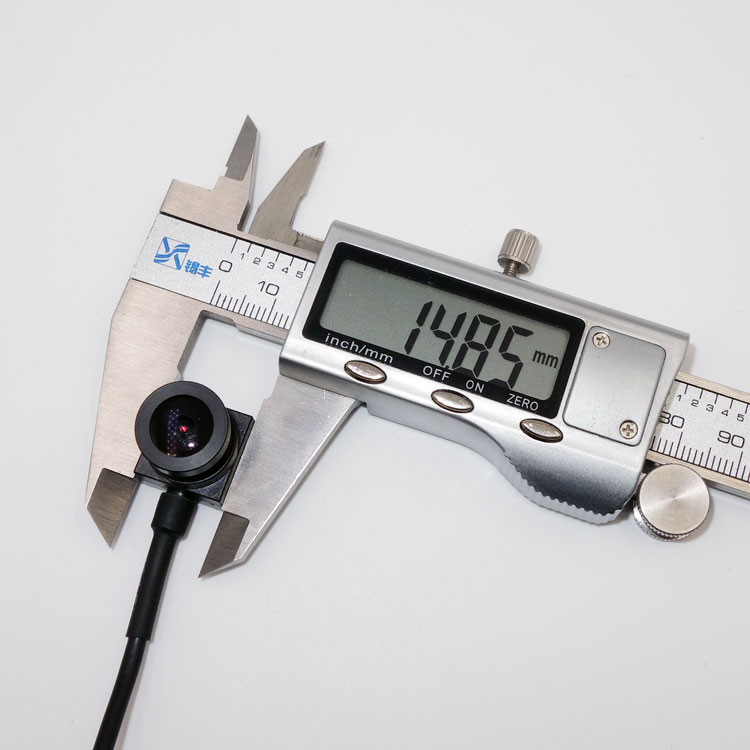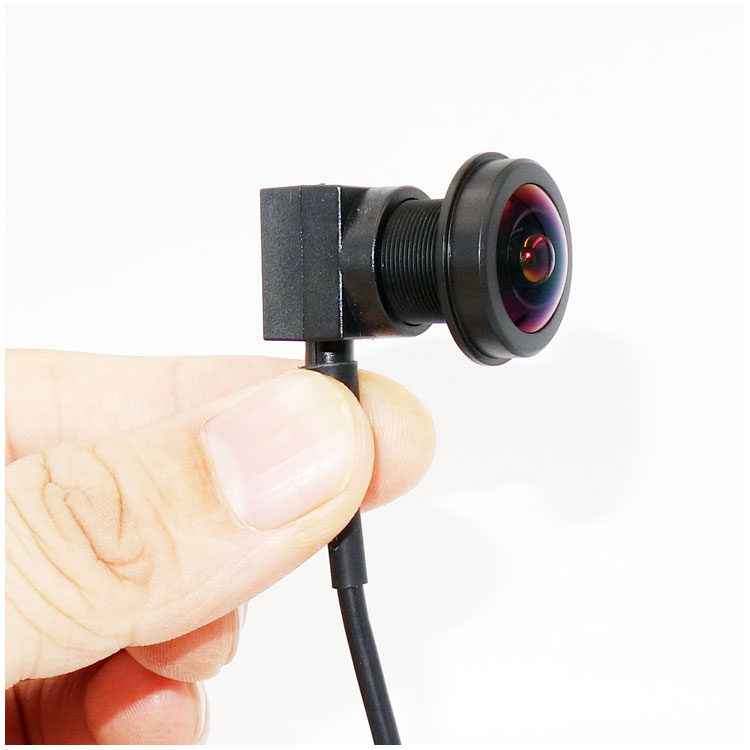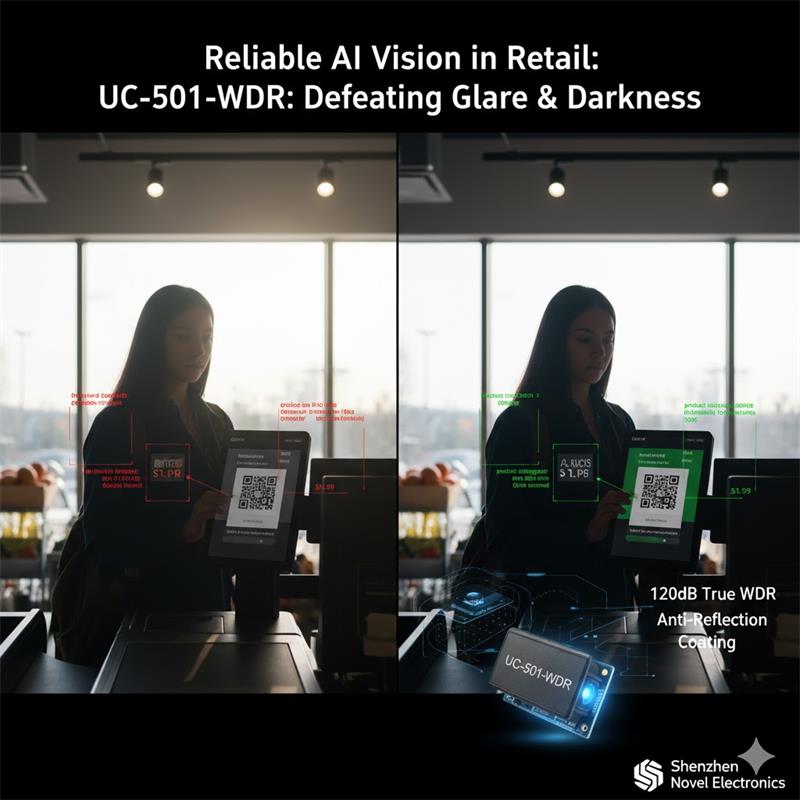
The revolution in retail automation is undeniable. AI-powered self-checkout systems, intelligent kiosks, and smart vending machines promise unprecedented efficiency and enhanced customer experiences. However, many promising computer vision retail solutions that perform flawlessly in controlled lab environments stumble dramatically when deployed into the chaotic reality of a retail store. The culprit? More often than not, it's not the sophistication of the AI algorithm, but the quality of the visual data it receives.
This is the classic "Garbage In, Garbage Out" principle in action. An AI model, no matter how advanced, cannot function reliably if its primary sensor—the camera—is blinded by the very environment it's designed to operate in. The complex and dynamic lighting conditions found in retail spaces represent the single greatest challenge to deploying robust and dependable ai retail camera systems.
This article delves into the demanding visual requirements of AI-powered retail terminals and introduces the UC-501-WDR, a specialized micro WDR USB camera module from Shenzhen Novel Electronics, engineered specifically to ensure your AI systems perform reliably in the real world.

Designing an effective vision system for a retail terminal requires overcoming a confluence of demanding technical hurdles:
1. The Rigorous Demands of AI Recognition: Retail AI tasks are diverse and demanding. Algorithms must identify a vast array of products with varying shapes, sizes, and textures (from fresh produce to packaged goods), read barcodes or QR codes accurately, and sometimes perform facial recognition for payment or loyalty programs. This requires image data that is:
High Fidelity: Sufficient resolution (like the 2MP of the UC-501-WDR) to capture fine details, accurate color representation, and minimal geometric distortion.
Consistent: AI models are sensitive to variations. Drastic shifts in brightness, contrast, or color caused by fluctuating light can lead to misidentification and poor performance. The camera for ai object recognition retail must deliver stable image characteristics.
2. The Retail Lighting "Traps": Retail environments are optical minefields for standard cameras:
Extreme Dynamic Range: The difference between the brightest and darkest areas often exceeds a standard camera's capability. Key scenarios include:
Harsh Backlight: Customers using a kiosk camera module near a bright window or entrance appear as silhouettes. This is a major issue for any camera for backlit retail display.
Intense Glare: Overhead spotlights reflecting off shiny packaging, wet produce, or even the glass screen of the terminal itself can create blinding white spots, obscuring crucial details for a wdr camera for self checkout. An anti glare camera retail kiosk solution is often needed.
Deep Shadows: Shelving, equipment structures, and uneven lighting create dark areas where details are lost. This impacts systems like a low light camera for smart vending machine interiors.
Complex Reflections: Glass doors, polished floors, and smartphone screens during payment add unpredictable reflections that can confuse AI algorithms.
3. The Realities of OEM Integration: Manufacturers of retail terminals operate under intense pressure:
Severe Space Constraints: Modern self-checkout units, kiosks, and smart vending machine camera integrations demand extreme miniaturization. Internal space is at a premium, requiring components like the camera module to be incredibly compact.
Accelerated Time-to-Market: Speed is critical. Engineers need components that are easy to integrate, preferably "plug-and-play," without lengthy driver development cycles. A reliable UVC camera for retail linux / android systems is highly desirable.
Cost-Effectiveness & Reliability: Components must be competitively priced for mass production while guaranteeing long-term, stable operation (often 24/7) in a demanding commercial environment. An embedded camera module for kiosk integration must be both robust and affordable.

The UC-501-WDR micro USB camera module is not just another component; it is a purpose-built solution engineered to directly address the specific challenges of AI vision in retail.
1. Core Weapon: 120dB True WDR Obliterates Lighting Problems: The standout feature of the UC-501-WDR is its implementation of hardware-based True WDR technology, rated up to 120dB. Unlike software-based Digital WDR (D-WDR) which merely adjusts a single, often compromised image, True WDR utilizes a multi-exposure fusion process. The sensor captures multiple frames at different exposure levels – short exposures for bright areas, long exposures for dark areas. The onboard Image Signal Processor (ISP) then intelligently combines these frames to produce a single, perfectly balanced image where details across the entire dynamic range are clearly visible.
(Insert a compelling comparison image/GIF here showing the UC-501-WDR vs. a non-WDR camera in a simulated retail backlight/glare scenario)
Value: This isn't just about a prettier picture; it's about usable data. True WDR directly translates to significantly higher AI recognition accuracy for products, faces, and codes, and ensures your terminal remains fully functional regardless of the time of day or ambient lighting conditions.
2. Optimal Form Factor: 15x15mm Size + USB/UVC Simplicity:
Micro Size Advantage: The 15x15mm footprint allows the UC-501-WDR to be seamlessly integrated into the tightest spaces within modern retail hardware designs. (Insert an illustration showing the module embedded in a kiosk or scale).
Integration Velocity: Crucially, the module utilizes a standard USB interface and adheres to the UVC (USB Video Class) protocol. For system integrators developing on Linux or Android platforms—the backbone of most modern retail terminals—this means true plug-and-play functionality. The weeks potentially spent on custom driver development and debugging are eliminated, drastically accelerating your product's time-to-market.
3. Solid Foundation: HD Resolution & Optical Flexibility:
Resolution Sweet Spot: The 2MP (1080p) resolution provides an excellent balance for many AI retail tasks. It delivers sufficient detail for accurate identification without overburdening the processing capabilities of typical edge AI hardware or consuming excessive USB bandwidth.
Adaptable Optics: The module features an interchangeable M12 lens mount. This critical feature allows you to select the precise Field of View (FOV) required for your specific application – whether it's a wide view for an AI scale's platform or a narrower view for QR code reading at a specific distance – further optimizing AI performance.

AI Weighing Scales: Accurately identifies reflective fruit labels or vegetables under harsh supermarket spotlights.
Self-Checkout Systems: Reliably scans payment QR codes even with screen glare; enables robust facial recognition against bright store entrances.
Smart Vending Machines / Cabinets: Clearly captures images of products inside, even when the open door allows bright external light to flood in, ensuring accurate stock tracking and charge calculation.
Informational & Service Kiosks: Provides clear video for identity verification or remote assistance, regardless of whether the user is backlit by outdoor light.
Choosing the right vision component is the critical first step toward reliable AI performance in your retail devices. The UC-501-WDR provides the essential combination of advanced WDR imaging, micro-miniature size, and effortless integration needed to conquer real-world challenges.
As a dedicated OEM camera module for retail devices supplier, Shenzhen Novel Electronics understands your specific needs.
Request our Whitepaper: "Selecting the Optimal Vision Component for AI Retail Terminals" for a deeper technical guide.
Get a UC-501-WDR Sample: Validate its superior performance in your own device and environment.
Contact Our Experts: Discuss your specific requirements and explore customization options. Let us help you find the perfect vision solution.
1. Q: How much control do I have over image parameters like exposure if it's UVC Plug-and-Play? A: Full control. UVC compliance exposes a standard set of controls via operating system APIs. On Linux, tools like v4l2-ctl allow you to script and manage parameters like manual exposure, gain, white balance, brightness, contrast, etc., enabling dynamic optimization for your AI model.
2. Q: What is the CPU load impact on an embedded system? A: Minimal if using the right format. The UC-501-WDR supports both MJPEG (compressed, requires CPU decompression) and YUY2 (uncompressed, zero CPU decode load). For AI terminals with sufficient USB bandwidth, YUY2 is recommended as it frees up the CPU entirely for AI inference.
3. Q: Can the cable and lens be customized for our specific kiosk design? A: Absolutely. We offer extensive customization, including various M12 lenses for specific FOVs, custom USB cable lengths (cm to meters), connector types (A, C, Micro, headers), and cable types (FFC, specific shielding). We work with your engineers to define the perfect fit.
4. Q: Is the 120dB WDR rating based on True WDR or Digital WDR? A: It is True WDR. Our UC-501-WDR utilizes hardware-based multi-exposure fusion within the sensor and ISP. This captures genuine detail in both highlights and shadows, providing significantly superior image data for AI compared to software-based Digital WDR techniques.
5. Q: What is the typical operating temperature range and reliability for this module in a 24/7 retail environment? A: The UC-501-WDR is designed for industrial and commercial reliability with a standard operating temperature range (e.g., -10°C to +70°C – check specific datasheet). We use high-quality components and rigorous testing to ensure stable, long-term performance suitable for 24/7 operation in typical retail terminal environments. We can provide detailed MTBF data and discuss specific environmental requirements for your project.
useful relative product application and WDR micro USB camera links
1, What is a WDR USB Camera & How Does True WDR Work?
2, Compact WDR USB Camera for Next-Gen EoAT & AMR Robotics Vision
3, UC-501-WDR True WDR USB Cameras: Conquer Lighting Challenges
4, NOVEL Technical white paper of micro usb camera with WDR UC-501-WDR
5, WDR Miniature USB Camera for Robotics, Kiosks & Vending & IOT UC-501-WDR
6, what is difference of WDR and HDR in usb camera module?